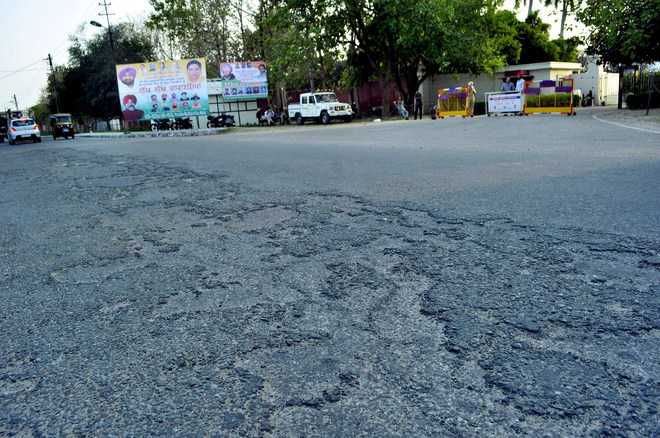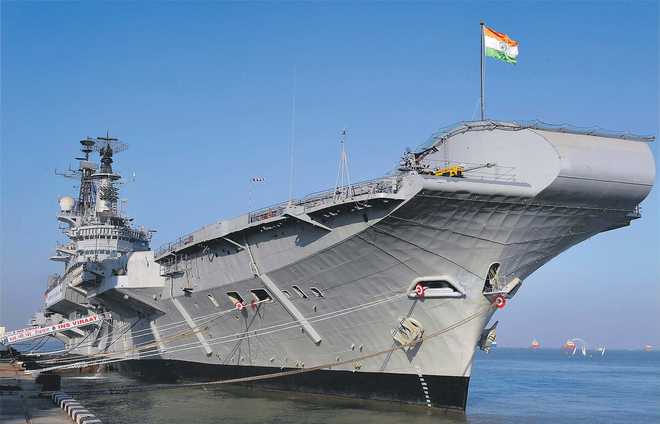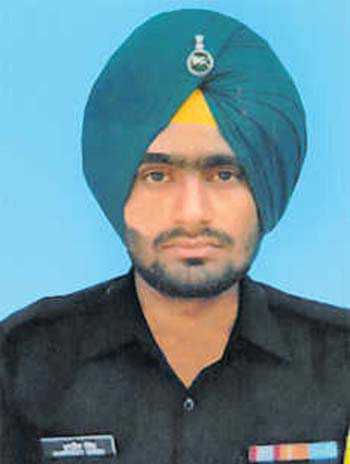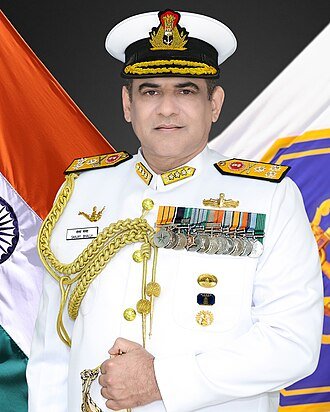
The damaged road outside Chief Minister Capt Amarinder Singh’s residence in Patiala. Tribune photo: Rajesh Sachar
Aman Sood
Tribune News Service
Patiala, March 20
Travelling on a road leading to the houses of Chief Minister Capt Amarinder Singh and his Cabinet colleague Brahm Mohindra makes for one bumpy ride, thanks to potholed roads.Besides the CM and Brahm Mohindra, two more ministers hail from the city.The road from Theekriwala Chowk to New Moti Bagh Palace was repaired a few times during the SAD-BJP tenure in the past 10 years, but was never relaid.The stretch was last spruced up during the Capt Amarinder’s government when the city hosted the India-Pakistan Games in December 2004. “Funds meant for the district were always diverted to Bathinda. The past 10 years saw no development. My government will ensure that the city is brought back on the path of development,” Capt Amarinder had said while canvassing in Patiala in January.On the evening of March 13, when Capt Amarinder reached his house after winning the elections, a battery of ministers, workers, bureaucrats and heads of departments came from across the state to congratulate him. They were, however, surprised to see the state of the road.“Paucity of funds with the Local Bodies Department was said to be the reason for repairing or relaying only a few roads in Patiala during the past SAD-BJP rule,” claimed Improvement Trust former chairman KK Sharma, a confidant of the royal family.“It is hoped things will change when Capt Amarinder visits for the first time as the Chief Minister. His first visit is pending and we hope that the work will start soon,” he said, adding that development of the city is government’s priority.The condition of roads across the district is bad, with the Municipal Corporation (MC) and the Public Works Department claiming shortage of funds.“Substandard work is the reason for the poor state of the roads,” a Congress worker said.“The MC will soon start the patchwork on all roads in the city. There are certain issues pertaining to relaying of roads. The civic body will take up the matter soon,” said MC Commissioner Gurpal Chahal.
City residents pin hopes on Amarinder Singh

Old and new photographs of Rajindra Lake in Patiala. Tribune photos: Rajesh Sachar
Gagan K Teja
Tribune News Service
Patiala, March 20
With Patiala again becoming the powerhouse of the state, the focus has once again shifted back on various development projects under the Patiala Municipal Corporation that are either underway or in pipeline. The formation of Congress government has certainly raised hopes of Patiala citizens who are now pinning hopes on Captain Amarinder Singh.The work of revival of Rajindra Lake, which had been lying in a state of utter neglect for years, had started one year ago with the district authorities receiving Rs 4 crore for its revival. The underground channels that bring water here from the Bhakra canal had already been repaired, but the project got stalled due to demonetisation.The pride of royal city, Rajindra Lake had become a centre of attraction after one of the previous deputy commissioners Jasbir Singh Bir took personal interest in its revival after he was posted at Patiala in 2000. The lake had been filled with canal water about and three fountains were also installed around the central structure of the lake, which used to oxygenate the lake water.The authorities had even introduced boats at the lake and it was frequently visited by the city residents till it dried up all together a few years ago. Even lotus flowers had been planted on the lakebed and it even had fish which was a major attraction. Last year, a rare 72-kg turtle was also discovered from the lakebed and the lake also played host to a number of migratory birds.At one point of time, it was being mulled to handover the upkeep of the lake to the State Tourism Department. It had even been planned that a water treatment plant would be set up here to keep the lake water fresh, but the project was rejected by experts.The civic body had made several attempts to revive the lake to promote tourism in the city but nothing concrete could come up. In 2010, a grant of Rs 22 lakh had been sanctioned by the state government for carrying out the beautification of the lake, but grants lapsed and nothing could be done for the lake’s revival. However, now that the process of revival has already begun, the Congress government will be giving a further push to the same.Meanwhile, the Patiala Municipal Corporation had identified 40-acre of land at Dudhar village for the solid waste management plant in 2010. Mandatory permissions from the Punjab Pollution Control Board (PPCB) and the panchayat department had been taken. While, 20 acres of land was transferred for the project, the remaining could not be transferred as the sarpanch of the Dhudhar village refused to sign the required NoC. Since then, the issue has been raised time and again but the project continues to be in pipeline.Notably, the state of Punjab had taken steps for treatment of solid waste and had divided the state into eight clusters for setting up of Integrated Municipal Solid Waste Management Plants at Ludhiana, Pathankot, Amritsar, Jalandhar, Bathinda, Patiala, Mohali and Ferozpur.As per the state-level master plan, these eight Municipal Solid Waste (MSW) Cluster projects were to be developed under the Public Private Partnership (PPP) mode for a concession period of 25 years. Each project included door-to-door collection of solid waste from all towns/cities of the state, transportation of the same, processing and scientific disposal in the common engineered landfill facilities to be developed in each cluster. Moreover, the project of shifting of dairy farming is also mid-way.
Revival of rajindra lake
The work on revival of Rajindra Lake, which had been lying in a state of utter neglect for years, had started one year ago with the district authorities receiving Rs 4 crore for its revival . The underground channels that bring water here from the Bhakra canal had already been repaired, but the project got stalled due to demonetisation.
























































 HT PHOTO
HT PHOTO























































